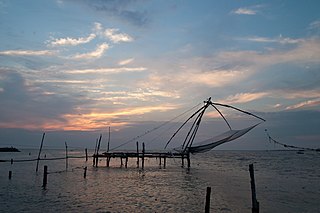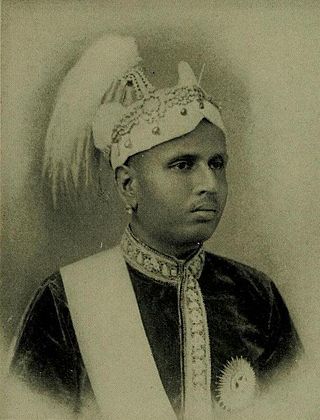Related Research Articles

The Kingdom of Travancore, also known as the Kingdom of Thiruvithamkoor or later as Travancore State, was an Indian kingdom that lasted from c. 1729 until 1949. It was ruled by the Travancore Royal Family from Padmanabhapuram, and later Thiruvananthapuram. At its zenith, the kingdom covered most of the south of modern-day Kerala and the southernmost part of modern-day Tamil Nadu with the Thachudaya Kaimal's enclave of Irinjalakuda Koodalmanikyam temple in the neighbouring Kingdom of Cochin. However Tangasseri area of Kollam city and Anchuthengu near Attingal in Thiruvananthapuram were parts of British India.

Vayalar Ramavarma, also known as Vayalar, was an Indian poet and lyricist of Malayalam language. He was known for his poems which include Sargasangeetham, Mulankaadu, Padamudrakal, Aayisha and Oru Judas janikkunnu and for around 1,300 songs he penned for 256 Malayalam films. He received the National Film Award for Best Lyrics in 1972 and was the winner of the Kerala State Film Award for Best Lyricist in its year of inception which he received three more times. He was also a recipient of the Kerala Sahitya Akademi Award for Poetry in 1962. His collaborations with G. Devarajan produced the golden era of Malayalam film music and many songs written and composed by these duo remain the ever green classics in Malayalam. Ramavarma is regarded as one of the most successful and critically acclaimed lyricist in the history of Malayalam cinema.
Rama is the legendary Indian king regarded as an incarnation of Vishnu.

Raja Ravi Varma was an Indian painter and artist. His works are one of the best examples of the fusion of European academic art with a purely Indian sensibility and iconography. Especially, he was notable for making affordable lithographs of his paintings available to the public, which greatly enhanced his reach and influence as a painter and public figure. His lithographs increased the involvement of common people with fine arts and defined artistic tastes among the common people. Furthermore, his religious depictions of Hindu deities and works from Indian epic poetry and Puranas have received profound acclaim. He was part of the royal family of erstwhile Parappanad, Malappuram district.

The Kingdom of Cochin, also known as the Kingdom of Kochi or later as Cochin State, named after its capital in the city of Kochi (Cochin), was an Indian Hindu kingdom in the central part of present-day Kerala state. It commenced at the early part of the 12th century and continued to rule until its accession to the Dominion of India in 1949.

Anizham Thirunal Marthanda Varma was the founding monarch of the southern Indian Kingdom of Travancore from 1729 until his death in 1758. He was succeeded by Rama Varma (1758–98). While he was the heir to the throne, he suggested to his uncle the idea of forming an alliance with the Mughal Nawab of Carnatic. Rama Varma pledged allegiance to the Mughal empire and embraced the title of "Zamindar of Malabar". The feudatory status of Travancore persisted even during the era of Hyder Ali.
Venad was a medieval kingdom lying between the Western Ghat mountains and the Arabian Sea on the south-western tip of India with its headquarters at the port city of Kollam (Quilon). It was one of the major principalities of Kerala, along with kingdoms of Kannur (Kolathunadu), Kozhikode (Nediyiruppu), and Kochi (Perumpadappu) in medieval and early modern period.
The New-York Mirror was a weekly newspaper published in New York City from 1823 to 1842, succeeded by The New Mirror in 1843 and 1844. Its producers then launched a daily newspaper named The Evening Mirror, which published from 1844 to 1898.

Kochi is an ancient city located in the Ernakulam District in the Indian state of Kerala about 200 km from Trivandrum, the capital of Kerala.

Sir Sri Moolam Thirunal Rama Varma VI (1857–1924) was Maharajah of the princely state of Travancore between 1885 and 1924, succeeding his uncle Maharajah Visakham Thirunal (1880–1885). Moolam Thirunal is considered as the first in Indian to implement the concept of public participation in governance through the formation of Travancore Legislative Council.

Sri Padmanabha DasaSir Sri Visakham Thirunal Rama Varma VFRAS, also known as Rama Varma the Learned, was the Maharaja of Travancore from 1880 to 1885 AD, succeeding his elder brother Ayilyam Thirunal on the musnud, or throne. He was a noted scholar of Sanskrit and literary composer in Malayalam, who reversed his brother's policy, liberally patronizing poet Kerala Varma, while hostile to painter Raja Ravi Varma.
Rajah Rama Varma was the ruler of the Indian kingdom of Venad, later known as Travancore, in the modern day state of Kerala, India between 1724 and 1729, having succeeded his brother Unni Kerala Varma. He is better known as the uncle of Maharajah Padmanabha Dasa Vanchi Pala Marthanda Varma Kulasekhara Perumal, the "maker of modern Travancore". He was born into the Royal Family of Kolathunadu, as the second son of Rajah Ittamar of Thattari Kovilakam. It was princes from the Parappanadu family who customarily married Kolathunadu princesses. Rama Varma's entire family, including himself, two sisters and his elder brother Unni Kerala Varma, were adopted into the Venad house as members of the Travancore Royal Family by Rajah Ravi Varma, nephew of Umayamma Rani due to the failure of heirs there. Ittammar Raja's sister and her sons, Rama Varma and Raghava Varma, settled in Kilimanoor and married the now adopted sisters. Of the adopted sisters, one died soon after her adoption while the other was the mother of the Maharajah Marthanda Varma.

The Travancore royal family was the ruling house of the Kingdom of Travancore.The Travancore royal family signed a treaty with the British in 1788, thereby adopting British dominance. Later, in 1805, they revised the treaty, leading to a diminution of royal authority and the loss of political independence for Travancore. They had to give up their ruling rights over the common people in 1949 when Travancore were forced to merge with Independent India and their political pension privileges were abolished in 1971.
The name Rama Varma refers to a number of persons from many royal families of Kerala in southern India.

Sir Sri Rama Varma XV (1852–1932), known as the Rajarshi of Cochin and as Ozhinja Valiya Thampuran, was the ruler of the Kingdom of Cochin from 1895 to 1914.
Rama Varma XI was an Indian monarch who ruled the Kingdom of Cochin from 1828 to 1837.
Rama Varma XIII was an Indian monarch who ruled the Kingdom of Cochin from 1844 to 1851.

Sree Padmanabhadasa Sree Moolam Thirunal Rama Varma is the current incumbent to the throne of Travancore. He is the youngest of the four children of the former titular Maharani of Travancore, Sree Padmanabhasevini Maharani Karthika Thirunal Lakshmi Bayi and her husband, Prince Consort Lt. Col. G. V. Raja of Poonjar Royal House.

Sri Moolam Thirunal Palace or SMP Palace or SMT Palace is a palace situated near the heart of the city of Kollam, in the state of Kerala, India. It was constructed in 1936 as a commemorate for the shashtabda poorthi of the then ruler of erstwhile Travancore, Moolam Thirunal Rama Varma.
References
- "List of rulers of Kochin". worldstatesmen.org.